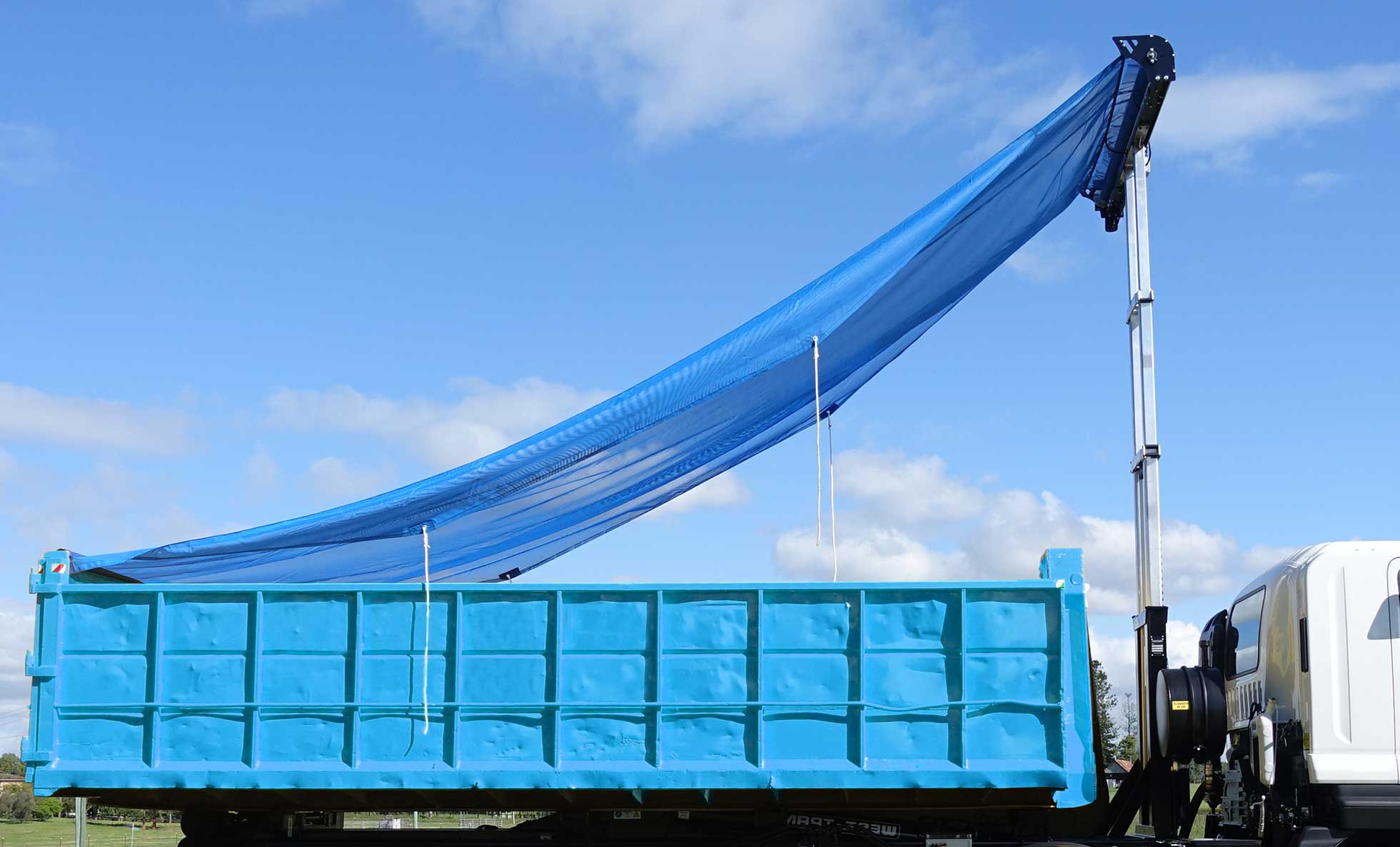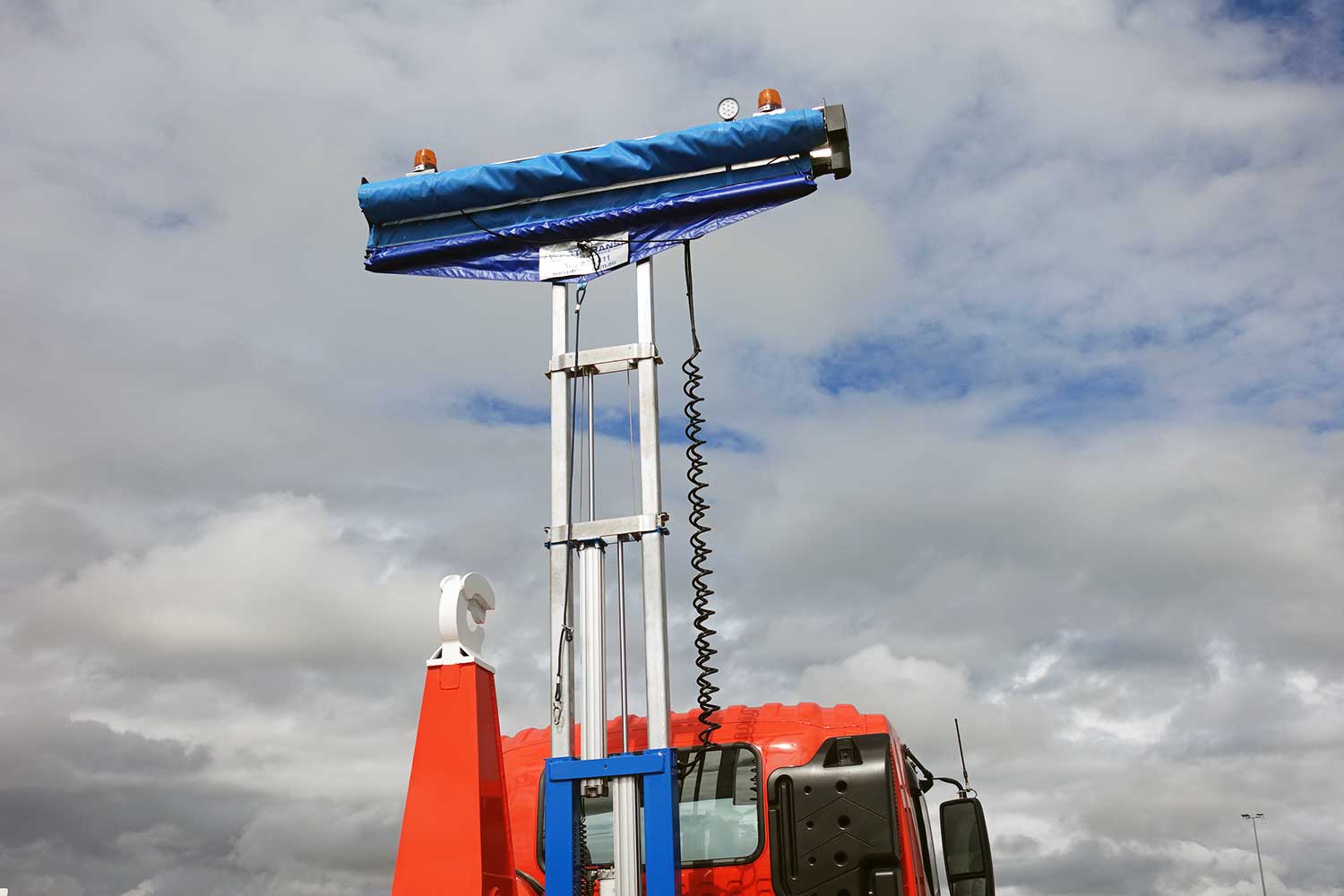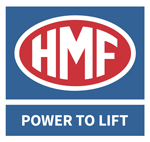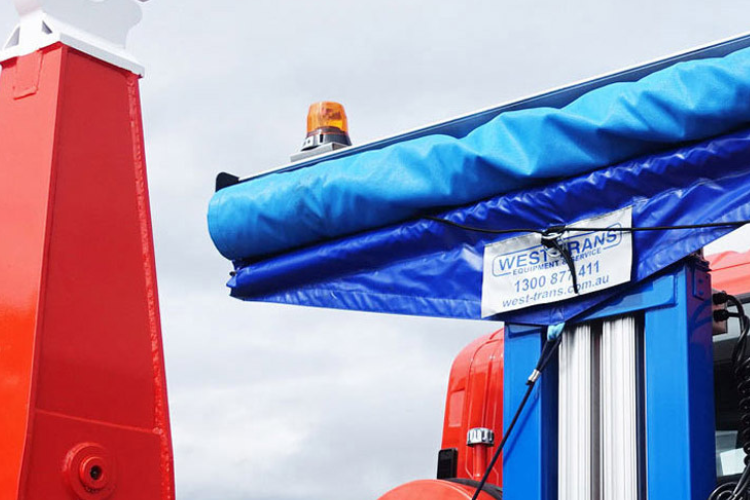When protecting your truckload while on the road, two main types of tarping systems are available: hydraulically or electronically operated tarping systems and manually operated tarping systems. One offers speed and convenience; the other is more budget-friendly and lightweight. But which one is right for your needs?
Let’s explore how you can choose the right tarp kit for your truck bed and highlight what are the key factors you should be looking for when making a purchase.
What is a Tarping System?
Tarping systems are an essential part of the construction, logistics, and waste management industries. These systems are fitted to trucks, trailers, or dump trucks to cover and secure loads. They also prevent damage from wind or other weather to the load and ensure loads consisting of smaller particles, like sand or dirt, are not scattered in the wind during high-speed transportation.
Types of Tarp Systems
There are several types of tarping systems available, including arm systems, roll-out systems, pull-out systems, and cable systems, but all ultimately fall into two categories:
Hydraulically or electronically operated tarping systems and manually operated tarping systems. These systems can be customised to suit specific vehicles and load types to ensure maximum safety and efficiency is delivered.

Hydraulically and Electronically Operated Tarping Systems
Advantages of Hydraulic Tarp Systems
These systems are incredibly fast and efficient, allowing for the covering or uncovering of a load with the simple press of a button. Hydraulic systems are ideal for heavy-duty applications, such as large trucks that would otherwise require a team of personnel to cover or uncover.
How Hydraulic Tarp Systems Work
A hydraulic cylinder powers the movement of the tarp arms. This means the entire system operates by a flick of a switch or a remote-control device. While these systems are sometimes referred to as “automatic”, it’s important to note that operators remain outside the cab to oversee the process and ensure proper coverage. Designed to be durable and long-lasting, hydraulic systems also provide ease of use and an additional element of safety to loading and unloading operations.
Manually Operated Tarping Systems
Advantages of Manual Tarp Systems
Manual tarp systems are cost-effective and simple to use but do require more personnel to operate during covering and uncovering. This makes them ideal for small-scale operations, where fewer people are required to physically cover or uncover the load. Manual systems are very low maintenance and can also be easily repaired if damaged.
How Manual Tarp Systems Work
Manual tarp systems require the physical exertion of manual labour to lift and then lower the tarp. This means personnel climbing up onto the truck and working to shift what can be a heavy tarp over the load and then securing it. The whole system typically consists of the tarp, the frame it covers, and the straps and clamps that hold it in place. While more labour-intensive, manual systems are also designed to be simple and easy to use.
Choosing the Right Tarp System
Cost Considerations
The right tarp system for your operation will depend on several factors, cost being one of the most important. Hydraulically and electronically operated systems typically have a higher upfront cost but can also provide long-term cost savings in the long run due to their increased efficiency. Using a hydraulic system is typically much faster and requires far fewer personnel.
Convenience and Safety
Manual tarps require more physical handling which can increase the risk of pinched fingers, muscle strains or other operator injury. It’s still crucial the operator of a hydraulic system remains alert during use, but the risk of injury is lower.
Versatility and Load Security
Hydraulic and electric operated systems can provide more secure coverage and can handle a large variety of loads. Manual systems require thorough checking and tying off to secure the tarp over the load, a time-consuming and laborious process.
Tarp System Installation and Maintenance
Common Mistakes to Avoid During Installation
One of the most common mistakes made during purchasing and installation is choosing a tarping system that is the wrong size for the truck. Other issues include improper placement and alignment when installing, so always follow the manufacturer’s instructions to the letter to ensure proper installation. This helps the system to work as designed and increases its longevity.
Regular Maintenance Tips
Like all machinery, tarping systems have their own regular maintenance requirements to keep them operating at their most effective. Give your system a thorough inspection and note any visual differences from the previous inspection. Clean the system regularly of dirt and grime, relubricate any moving parts, and replace worn-out parts as soon as you notice them. Altogether, these tips can help you extend the life of your system and prevent inconvenient breakdowns.
Truck Tarp Systems: Specialised Applications
Asphalt Hauling and Large or Unusual Loads
The type of load you transport should influence what type of tarping system you need and whether you will require a specialised system. For example, asphalt hauling, as well as large or unusually shaped loads, are two types that benefit from the secure coverage provided by specialised hydraulically or electronically operated systems.
Electric vs Manual Tarp Systems: A Comparison

Financial Assessment
Like hydraulic systems, electric systems typically come with a higher upfront cost which is offset by the long-term cost savings provided by its convenience and time-saving qualities. A financial assessment based on your usage can help you evaluate the best option for your business.
Operational Differences
Powered by electricity, and made up of components including a motor, cables, and pulleys, the electric tarp system is fast and efficient and ideal for quickly loading or unloading heavy loads. Like the hydraulic system, electric tarp systems remove the physical element from tarp covering, massively improving the safety element in covering and uncovering.
Troubleshooting Common Issues
Identifying Problems with Your Tarp System
The most common issues found in tarping systems are a result of worn-out parts, damage from improper installation, or a lack of general maintenance, which includes cleaning the system and lubricating any moving parts. Regular inspection and maintenance can help identify and resolve issues early, but if your tarping system is operating at a slower pace, making strange sounds during operation, or exhibiting other unusual signs, it’s time to dig deeper.
Repair and Replacement Options
The two options available once a problem has been diagnosed are repair and replacement. If caught early, most issues can be repaired, but if a component has been allowed to wear down enough, the part may need replacing. It is always important to follow the manufacturer’s instructions and to only use genuine parts designed specifically for your system. Using alternatives can cause further damage.
The Future of Tarp Systems: Emerging Technologies
Mesh Tarps and Beyond
Innovations and emerging technologies are coming out all the time, including new durable materials, such as the use of specialised mesh tarps. These high-density commercial-grade tarps can be ultraviolet-treated, making them immune to degradation and damage from UV rays. Some meshes are also mildew and rot-resistant, making them incredibly durable while providing all the versatility and load security expected from a modern tarping solution.
Electric Flip Tarp Systems
Electric flip tarp systems are another option emerging in markets as a popular choice. Rather than traversing along a straight horizontal axis, the flip tarp reaches up and over the load before securing it at the back of the truck’s bed. This is like placing plastic wrap over food, with the vertical movement giving you increased reach to cover large or unusually shaped loads, providing full coverage.
Your Next Tarping Solution is Here
The right tarping system for your operation depends on several factors, such as whether you need something as large as our dump truck tarp kits, have the personnel and smaller truck size suited for a manual tarping system, or need to save as much time as possible by employing hydraulic or electronic tarping systems.
Ultimately, the best tarp system depends on your operational needs and budget, so whether you’re managing a fleet or running a local business with a single truck, get in touch with the team at West-Trans Equipment to let us help you make an informed decision about your next tarping system.


